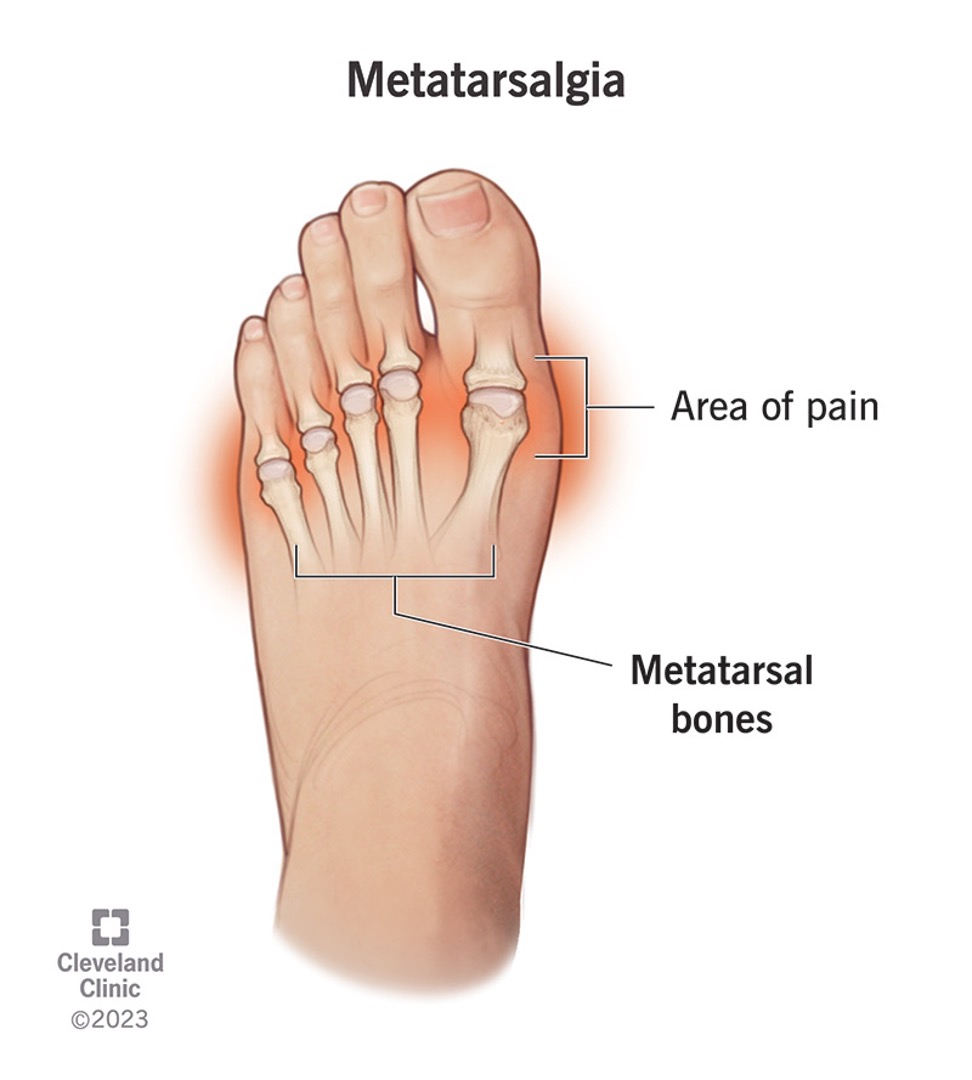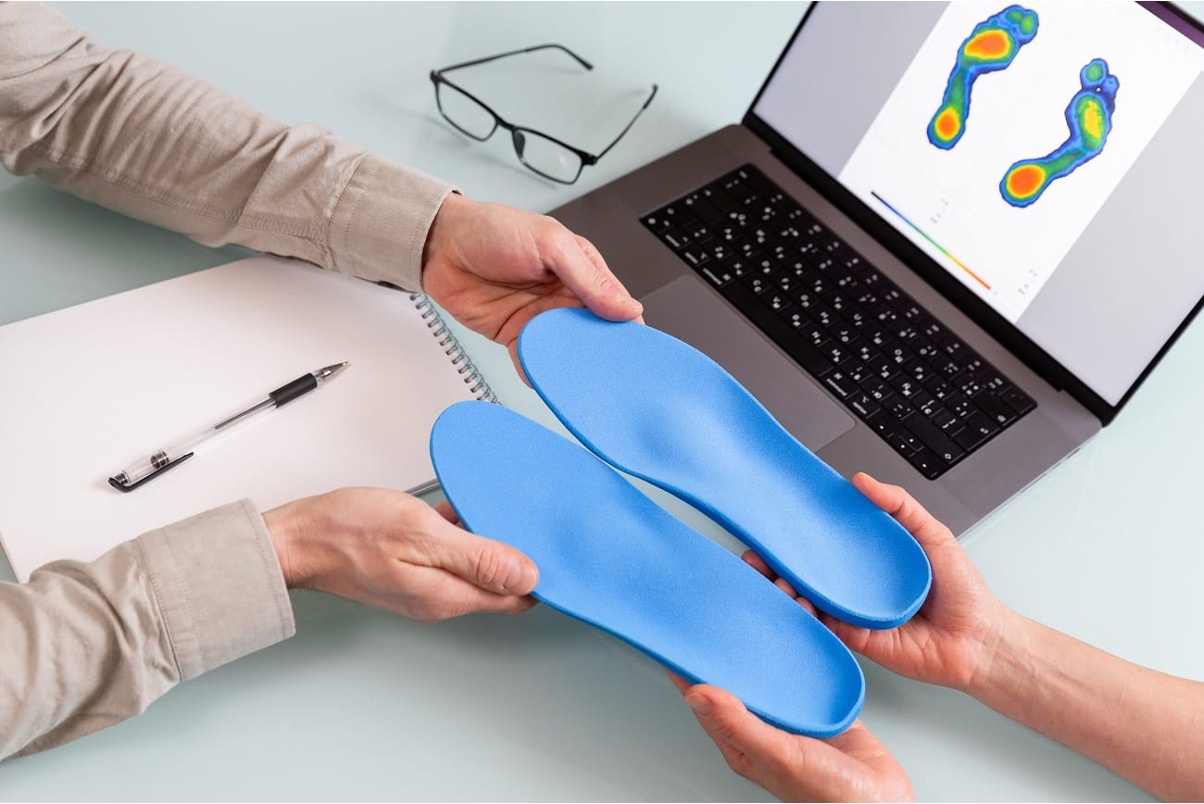Forefoot Pain: Symptoms, Causes, Treatment & Exercises
:format(webp)/cdn.mskdoctors.com/storage/2025/3/1NtYmcFUT84461wEUaL6hzzfma6E9o09.jpg)
Key Takeaways
-
Forefoot pain can stem from various conditions, including metatarsalgia, Morton's neuroma, stress fractures, and bunions.
-
Addressing forefoot pain at the first signs of discomfort can prevent progression to chronic conditions and reduce recovery time significantly.
-
Wearing properly fitted shoes with adequate support, maintaining a healthy weight, and incorporating foot-strengthening exercises can help prevent forefoot pain recurrence.
-
At MSK Doctors, we offer specialised musculoskeletal expertise for diagnosing and treating forefoot conditions, using advanced diagnostic imaging and personalised treatment plans.
Forefoot Pain Overview
Forefoot pain usually develops over time and is often a result of excessive pressure on the metatarsals, which are the long bones in the front of the feet. This discomfort, typically experienced in the ball of the foot or between the toes, can range from a mild nuisance to debilitating pain that makes even simple walking difficult.

Forefoot pain can intensify with physical activities. (Image courtesy of Cleveland Clinic)
Athletes facing the consequences of high-impact training, professionals who spend long hours standing, or someone dealing with the effects of ill-fitting footwear can all experience forefoot pain. Understanding the underlying mechanisms of this pain is the first step toward finding effective relief.
|
Forefoot Pain Symptoms
The pain typically presents as a sharp or burning sensation in the ball of the foot. The intensity of the pain can vary from a dull ache to a sharp, stabbing sensation. This discomfort can intensify with physical activities such as running, jumping, or even standing for extended periods.
Swelling is another common symptom of forefoot pain. This swelling occurs due to inflammation in the metatarsal area, leading to discomfort and a feeling of tightness in the foot. The swelling can make wearing shoes uncomfortable and may even alter the way you walk.
Besides that, you might feel like there's a pebble in your shoe, which is a common sign of metatarsalgia.
Causes of Forefoot Pain
High-Impact Activities
Engaging in high-impact activities, such as running and jumping, can place excessive stress on the forefoot. Athletes and active individuals are particularly prone to developing forefoot pain due to the repetitive impact on the metatarsals. It is necessary to incorporate rest days and proper footwear into your routine to mitigate the risk.

Athletes are particularly prone to developing forefoot pain.
Ill-Fitting Shoes
Wearing shoes that don't fit properly can significantly contribute to forefoot pain. Shoes that are too tight or have insufficient cushioning can lead to increased pressure on the ball of the foot. It's essential to choose footwear that provides adequate support and fits comfortably to prevent pain and discomfort.
Obesity and Foot Structure
Excess body weight can increase the pressure on the forefoot, leading to pain and inflammation. Additionally, certain foot structures, such as high arches or flat feet, can predispose individuals to forefoot pain. Weight management and custom orthotics are effective ways to alleviate these issues.
Underlying Health Conditions
Conditions such as arthritis, diabetes, and nerve disorders can also cause or exacerbate forefoot pain. These conditions often lead to inflammation and changes in foot structure, which can contribute to discomfort.
Treatment Options
Rest and Ice Application
Resting the affected foot and applying ice are simple yet effective ways to reduce pain and swelling. By giving your foot a break from high-impact activities and applying ice packs for 15-20 minutes several times a day, you can help reduce inflammation and promote healing.
Pain Medication
Over-the-counter pain relievers, such as ibuprofen or acetaminophen, can provide temporary relief from forefoot pain. These medications help reduce inflammation and alleviate discomfort. Make sure you follow the recommended dosage and consult with a healthcare provider if you have any concerns or if the pain persists despite medication.
Custom Orthotics

Custom orthotics can reduce stress on the metatarsals.
Custom orthotics are specially designed shoe inserts that provide additional support and cushioning to the feet. If you experience persistent forefoot pain, consulting a podiatrist for custom orthotics might be beneficial. These inserts can be designed to your specific foot structure and needs.
Physical Therapy
A physical therapist can guide you through exercises and techniques that strengthen the muscles in your feet, improve flexibility, and enhance overall foot function. This professional guidance can accelerate recovery and help prevent future episodes of pain.
Exercises for Forefoot Pain
Toe Pumps
Toe pumps are simple yet effective exercises that help improve circulation and reduce swelling in the forefoot.
-
Sit comfortably and extend your leg.
-
Gently point and flex your toes repeatedly, aiming for 10 to 15 repetitions per foot. This movement encourages blood flow and helps relieve tension in the feet.
Foot Stretching
Stretching the muscles in your feet can alleviate tension and improve flexibility.
-
Sit down and cross one foot over the opposite knee.
-
Use your hands to gently pull back on your toes until you feel a stretch along the bottom of your foot.
-
Hold this position for 15 to 30 seconds and repeat on the other foot.
Calf Raises
Calf raises help strengthen the muscles in your calves and feet, providing better support and reducing forefoot pain.
-
Stand with your feet shoulder-width apart, holding onto a chair or wall for balance.
-
Slowly rise onto your toes, lifting your heels off the ground.
-
Hold the position for a few seconds before lowering your heels back down.
-
Repeat this exercise 10 to 15 times.
Strengthening Exercises
Strengthening exercises target the muscles in your feet and ankles, enhancing their ability to support your body weight and absorb shock.
Loop a resistance band around your toes and gently pull it towards you while pushing your toes away. This resistance helps build strength in the foot muscles.
Practical Tips and Recommendations
Daily Foot Care Routine
Establishing a daily foot care routine can help maintain healthy feet and prevent forefoot pain. This routine should include washing your feet daily, moisturising to prevent dryness, and trimming your toenails regularly. Additionally, inspect your feet for any signs of swelling, redness, or changes in appearance - and address any issues promptly.
Weight Management Importance
Maintaining a healthy weight is essential for reducing the pressure on your forefoot. Excess weight can exacerbate pain and increase the risk of developing foot problems. Incorporating a balanced diet and regular exercise into your lifestyle can aid in weight management and improve overall foot health.
By managing your weight, you can significantly decrease the stress placed on your feet and prevent pain.
Preventive Measures
Preventing forefoot pain involves taking proactive steps to protect your feet. This includes wearing appropriate footwear, engaging in regular foot exercises, and avoiding activities that place excessive strain on your forefoot. By prioritising foot health, you can reduce the likelihood of experiencing pain and discomfort.
Implementing these preventive measures can lead to healthier, pain-free feet.
MSK Doctors Excellence
At MSK Doctors, we pride ourselves on providing comprehensive care for individuals experiencing forefoot pain. Our team of experts is dedicated to offering personalised treatment plans that address the unique needs of each patient. We understand the impact that foot pain can have on your daily life, and we are committed to helping you find relief and regain your mobility.
From non-invasive therapies to advanced surgical procedures, we tailor our approach to suit your specific condition. Our team stays at the forefront of medical advancements, ensuring that you receive the most effective and up-to-date treatments available.

Our goal is to help you achieve long-term relief and improve your overall quality of life.
With the right care and treatment, you can find relief and enjoy an active lifestyle once again. Book your consultation with MSK Doctors for forefoot pain today!
Frequently Asked Questions (FAQ)
What is the best shoe type for preventing forefoot pain?
The best shoes for preventing forefoot pain are those with ample cushioning, good arch support, and a roomy toe box. Avoid high heels and shoes that are too tight, as they can increase pressure on the forefoot and exacerbate pain.
Can exercises worsen forefoot pain?
Exercises, when performed correctly, should not worsen forefoot pain. In fact, they can help strengthen the muscles and improve flexibility. However, you have to follow a guided exercise program and avoid any activities that cause discomfort.
How long does it take for forefoot pain to improve?
The time it takes for forefoot pain to improve varies depending on the severity of the condition and the treatment approach. With consistent care and adherence to treatment recommendations, many individuals experience significant improvement within a few weeks.
Are there any specific exercises to do to alleviate forefoot pain?
Yes, there are specific exercises that can help alleviate forefoot pain. These exercises focus on strengthening the muscles, improving flexibility, and enhancing circulation in the feet. Some effective exercises include toe pumps and calf raises.
Why choose MSK Doctors for your chronic forefoot pain management?
Choosing MSK Doctors for your chronic forefoot pain management ensures that you receive expert care from a team of dedicated professionals. Our comprehensive approach to treatment, combined with our commitment to patient education and support, sets us apart in providing exceptional care.
:format(webp)/cdn.mskdoctors.com/storage/2025/5/lDQqx3rAB6q6Z7wCvYIHB7HfAeL2J9sW.jpg)
:format(webp)/cdn.mskdoctors.com/storage/2025/5/6NAtUY0TInuAFOF6ylhh7Y3k2O0gCAiL.jpg)
:format(webp)/cdn.mskdoctors.com/storage/2025/5/aIMSrJCWBNrLQKZXwdbd61WHOgFu6Jbo.jpg)
